What is an SQDECC Board?
SQDECC is a structured framework applied across industries to monitor and improve six critical performance dimensions: Safety, Quality, Delivery, Engagement, Cost, and Compliance. By systematically tracking these areas, organisations drive operational excellence and foster sustainable growth.
- Safety: Building a strong safety culture by proactively identifying risks, enforcing preventive actions, and ensuring compliance with regulations to protect employee well-being and maintain operational reliability.
- Quality: Achieving superior product and service standards through rigorous quality control, defect prevention, and continuous process optimisation to consistently meet or exceed customer expectations.
- Delivery: Ensuring timely and accurate delivery of goods and services by streamlining processes, reducing lead times, and improving logistics efficiency to meet customer demands effectively.
- Engagement: Fostering a motivated and committed workforce by promoting collaboration, supporting career development, and recognising employee contributions to drive team performance and satisfaction.
- Cost: Enhancing financial performance by managing operational expenses, reducing waste, and optimising resource usage to maximise profitability and maintain cost efficiency.
- Compliance: Upholding standards by adhering to legal, regulatory, and internal policy requirements, ensuring ethical operations and minimising organisational risks.
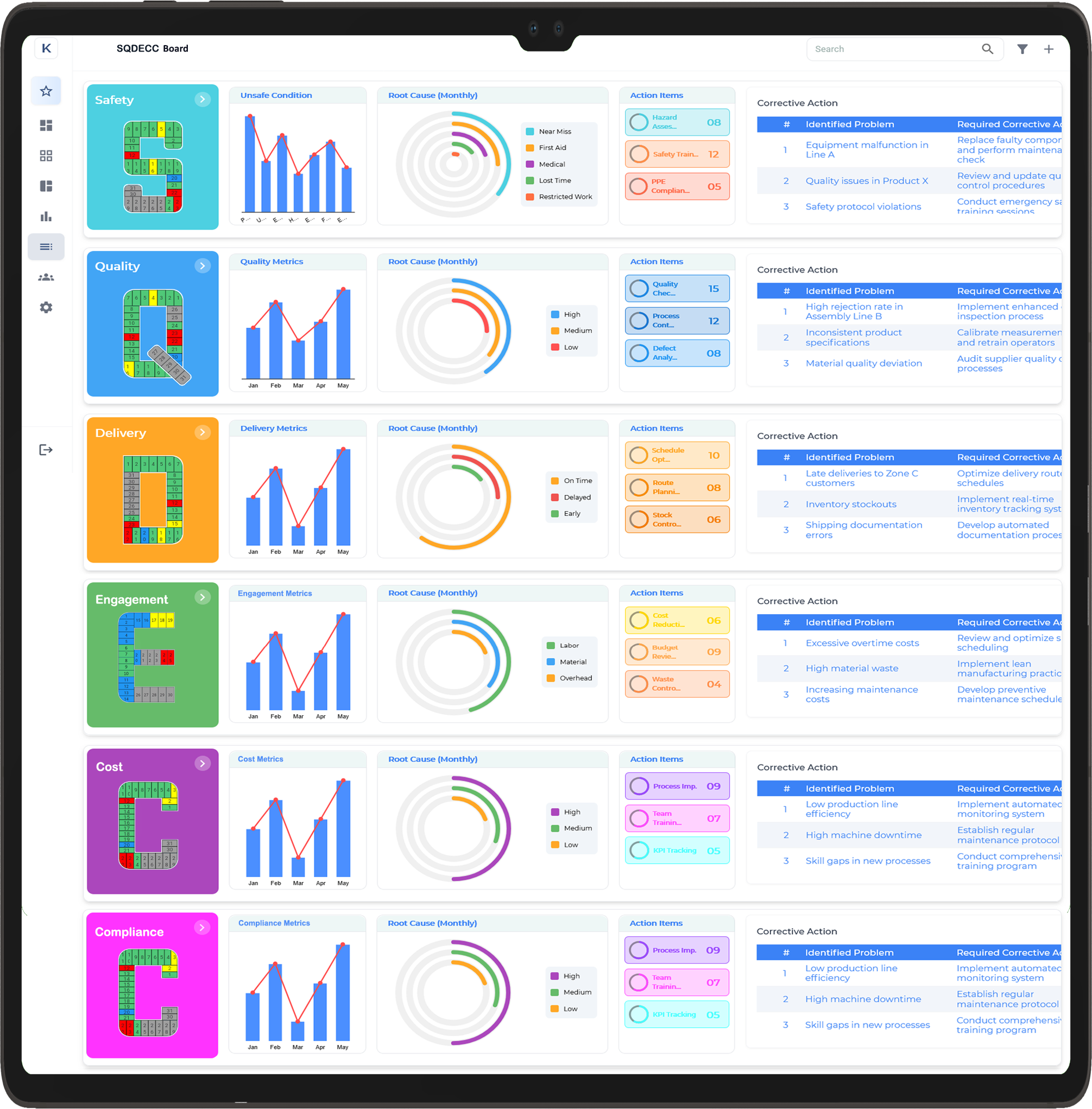
Safety
Effective safety management is essential for creating a secure, compliant, and resilient workplace. By using the Balanced Scorecard approach, organisations can systematically monitor safety performance, proactively address risks, implement preventive strategies, and strengthen a culture of safety that safeguards employees and ensures business continuity.
- Implementation of proactive safety measures and comprehensive risk mitigation strategies
- Continuous monitoring and reporting of workplace incidents, hazards, and near-misses
- Execution of thorough safety audits and adherence to regulatory compliance requirements
- Delivery of targeted safety training sessions and awareness initiatives for all employees
- Ongoing evaluation and enhancement of safety procedures and protocols
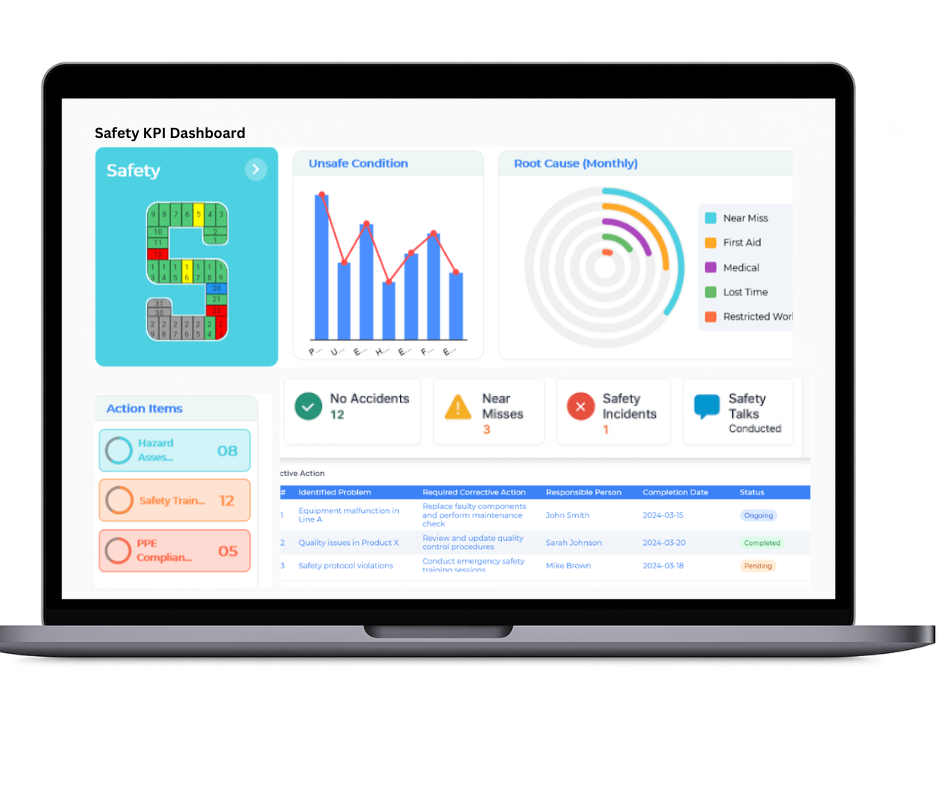
Quality
The Balanced Scorecard’s quality indicators provide a comprehensive framework for evaluating product integrity and process performance. By tracking critical metrics such as defect occurrence, inspection results, rework incidents, and non-conformance reports—along with feedback from both suppliers and customers—organisations can enhance their quality control systems and drive continuous improvement in operational excellence.
- Identification and analysis of product defects
- Documentation of failures from quality inspections and functional testing
- Monitoring of rework activities and implementation of corrective actions
- Issuance and management of Non-Conformance Reports (NCRs) for deviations in quality
- Effective resolution of supplier-related material quality issues
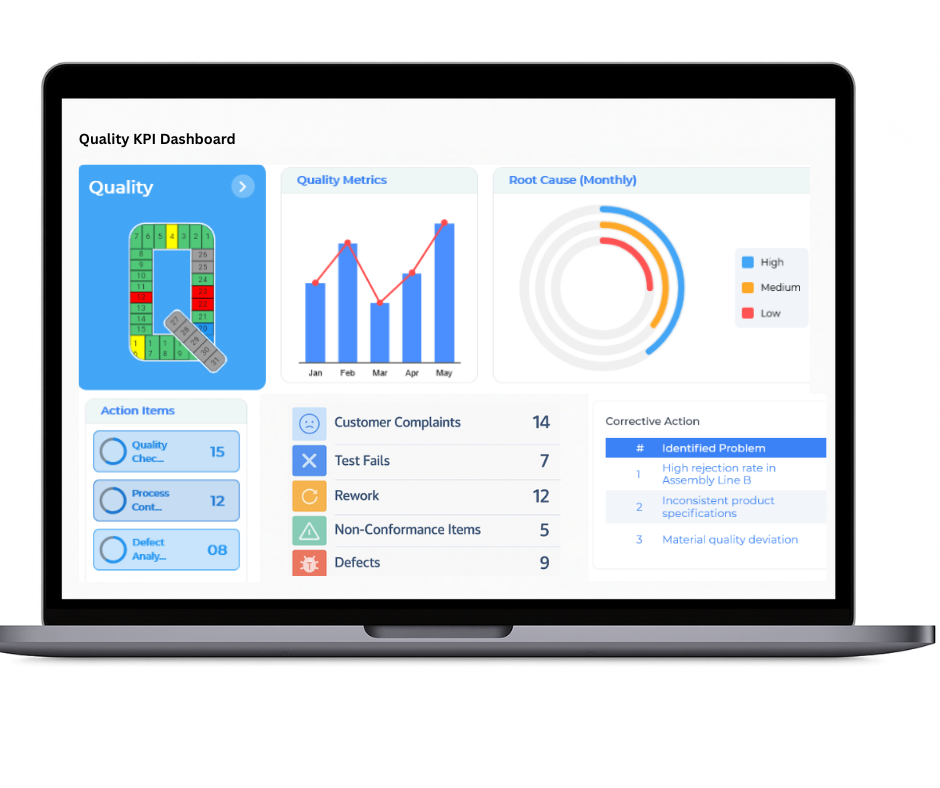
Delivery
The Balanced Scorecard offers a strategic view of delivery performance, ensuring timely and reliable fulfillment from supplier dispatch to customer receipt. By monitoring logistics efficiency, order accuracy, and inventory flow, it helps teams pinpoint bottlenecks, optimise processes, and improve overall supply chain effectiveness.
- Investigation and analysis of delayed shipments and their root causes
- Tracking of On-Time In-Full (OTIF) delivery performance
- Verification of order fulfillment accuracy and consistency
- Evaluation of warehouse operations and inventory cycle efficiency

Engagement
The Balanced Scorecard plays a crucial role in enhancing employee and team engagement by systematically measuring and fostering a positive workplace culture. By analysing key engagement drivers and identifying areas for improvement, organisations can boost morale, improve retention, and create a more motivated and productive workforce.
- Implementation of employee engagement initiatives and team-building activities
- Tracking of employee satisfaction and feedback through surveys and reviews
- Monitoring of employee turnover and retention metrics
- Analysis of professional development opportunities and career growth programs

Cost
The Balanced Scorecard plays a crucial role in managing costs by systematically tracking financial performance and operational expenses. By evaluating cost drivers, identifying inefficiencies, and optimising resource allocation, organisations can enhance profitability, maintain budget discipline, and achieve sustainable financial growth.
- Tracking of operational and departmental expenditures
- Implementation of cost-saving initiatives and process optimisations
- Monitoring of budget variances and corrective actions
- Analysis of resource utilisation and waste reduction efforts
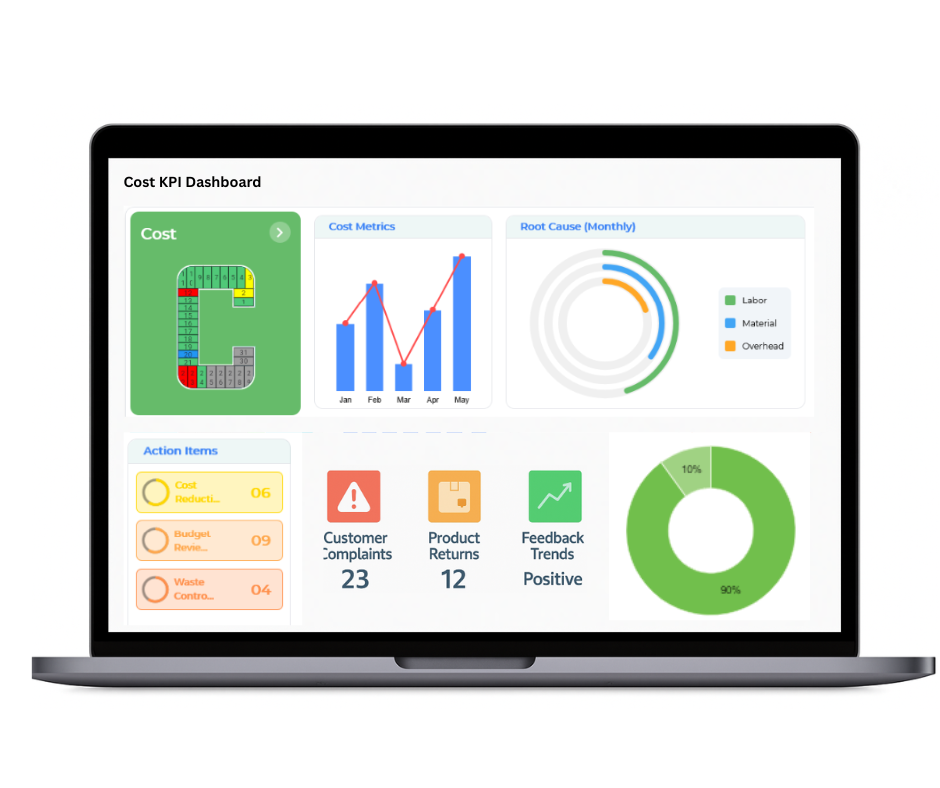
Compliance
The Balanced Scorecard plays a vital role in ensuring compliance by systematically monitoring adherence to regulatory standards, internal policies, and industry requirements. By evaluating compliance metrics, identifying gaps, and enforcing corrective actions, organisations can minimise risks, ensure ethical operations, and maintain regulatory integrity.
- Tracking of regulatory compliance and internal policy adherence
- Implementation of corrective actions for non-compliance issues
- Monitoring of audit results and compliance audit follow-ups
- Analysis of risk management processes and mitigation strategies
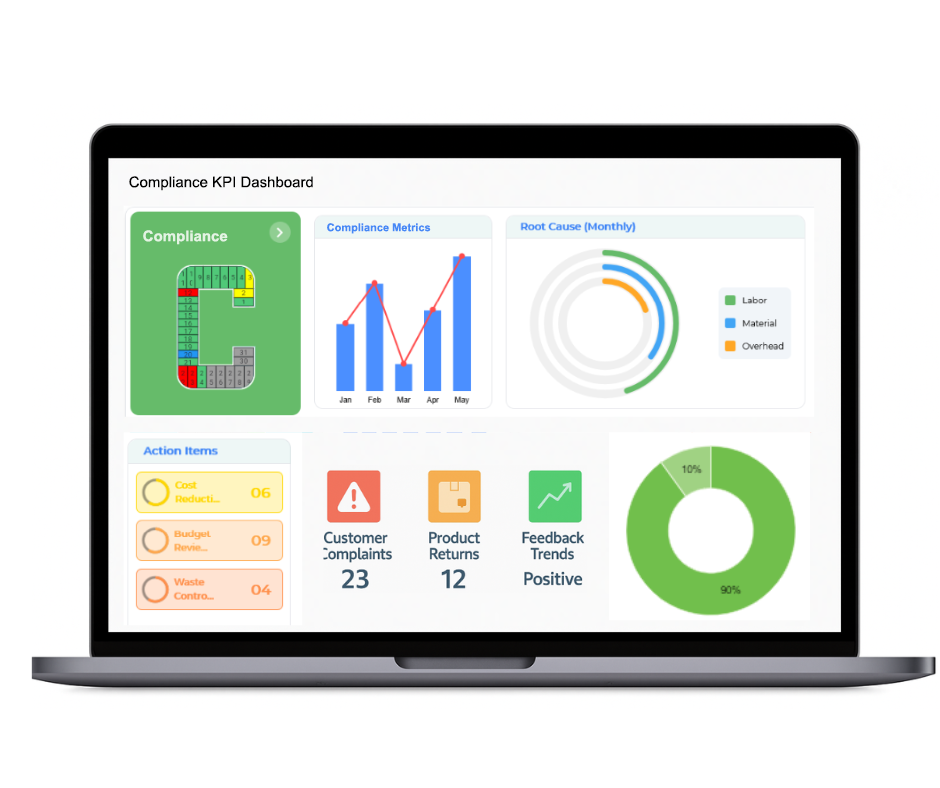
SQDECC Board for Shift Management
- Continuous Performance Monitoring: Tracks key metrics in Quality, Cost, Delivery, Morale, and Safety to ensure alignment with organisational objectives and drive improved operational outcomes.
- Quality Assurance: Monitors product quality, defect rates, inspection outcomes, and customer feedback to uphold high standards and foster continuous product improvement.
- Cost Management and Efficiency: Tracks operational expenditures, identifies cost-saving opportunities, and optimises resource allocation to enhance financial performance.
- On-Time Delivery Optimisation: Evaluates delivery performance against targets, analyses bottlenecks, and streamlines processes to ensure accurate and timely order fulfillment.
- Employee Morale and Engagement: Measures employee satisfaction, tracks training progress, and assesses overall morale to foster a motivated, collaborative, and productive workforce.
- Safety and Risk Management: Monitors safety metrics, tracks incidents and near-misses, and implements proactive risk-reduction measures to ensure a safe working environment.
- Environmental Compliance and Sustainability: Tracks energy consumption, waste management, and emissions to align with sustainability goals and meet regulatory requirements.
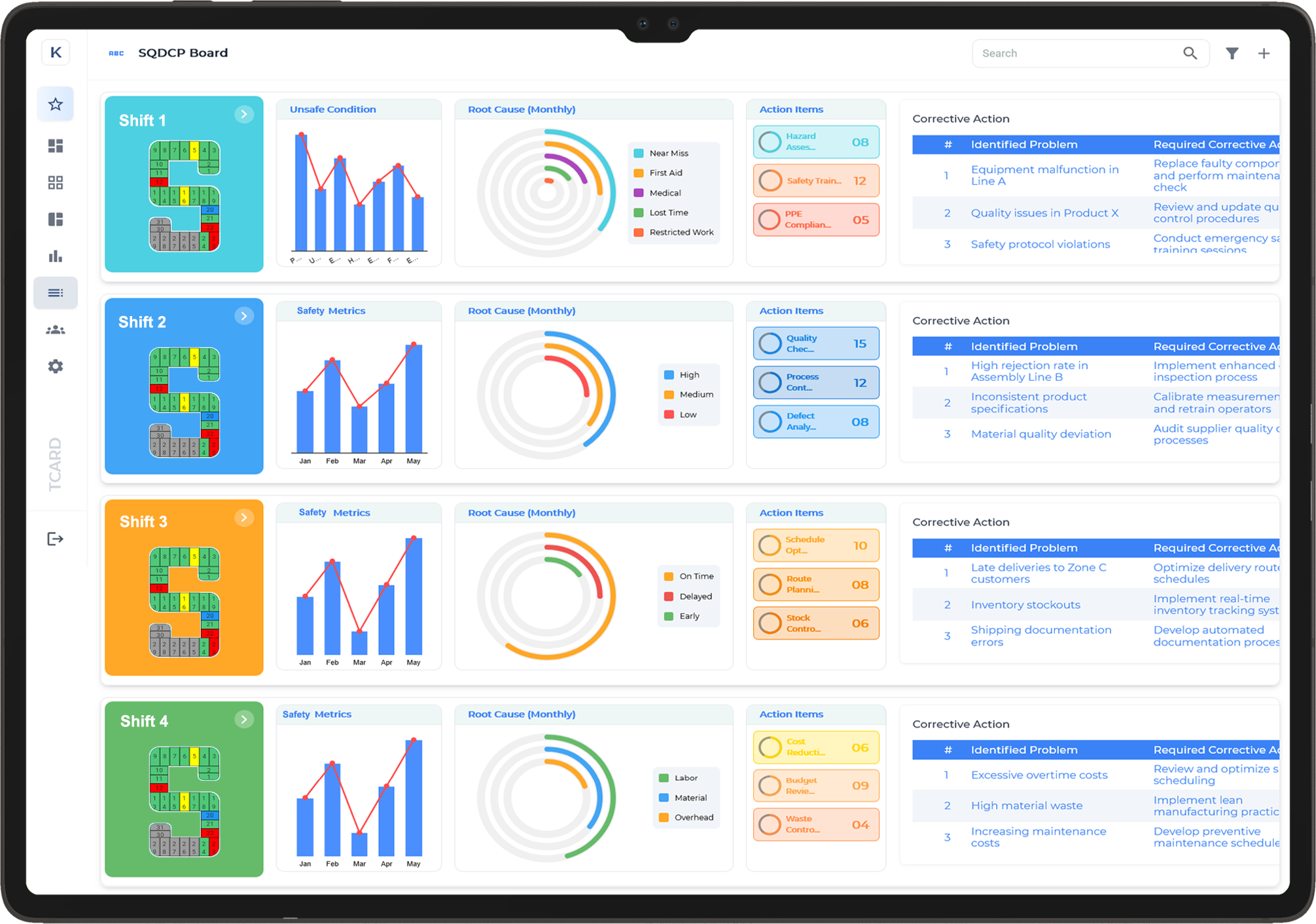
What is an SQDECC Board? Understanding Its Role in Operational Excellence
An SQDECC board is a visual tool used in operational excellence to monitor and improve performance across multiple key areas. The acronym SQDECC stands for Safety, Quality, Delivery, Efficiency, Cost, and Compliance. Each of these elements represents a critical focus area that organisations aim to optimise in their day-to-day operations.
1. Safety
Safety is the top priority in any workplace. The SQDECC board tracks safety metrics to ensure that the environment remains hazard-free, promoting a culture of safety awareness among employees. Monitoring safety incidents helps prevent accidents and improves workplace well-being.
2. Quality
Quality control is essential for maintaining consistent standards and customer satisfaction. The board displays quality metrics, such as defect rates and process variability, helping teams quickly identify and address quality issues to improve products or services.
3. Delivery
Delivery focuses on meeting customer demands on time. The SQDECC board helps track on-time delivery rates, ensuring that teams meet deadlines and customer expectations. This leads to improved customer satisfaction and loyalty.
4. Efficiency
Efficiency is about optimising workflows to reduce waste and increase productivity. The SQDECC board provides insights into process efficiency, helping teams identify bottlenecks and implement solutions that streamline operations.
5. Cost
Cost control is a key factor in maintaining profitability. The SQDECC board monitors operational costs, highlighting areas where expenses can be reduced without compromising quality or delivery standards.
6. Compliance
Compliance ensures that the organisation meets regulatory requirements and industry standards. The board tracks compliance metrics, helping to prevent violations and maintain a strong reputation in the market.
By integrating all these elements into one visual board, the SQDECC board enables real-time tracking of operational performance, fosters a culture of continuous improvement, and supports better decision-making for organisational success.
The Importance of Safety, Quality, and Efficiency in an SQDECC Board
In the context of an SQDECC board, Safety, Quality, and Efficiency are three foundational pillars that help drive operational excellence. These key elements are essential for any organisation aiming to maintain high performance, minimise risks, and optimise their processes.
1. Safety
Safety is the top priority in every workplace, and it holds the utmost significance on an SQDECC board. Tracking safety metrics ensures that risks are identified and managed before they result in accidents or injuries. By focusing on safety, organisations can create a safer work environment, increase employee morale, and reduce the financial costs associated with workplace accidents.
2. Quality
Quality is crucial for customer satisfaction and organisational success. In an SQDECC board, quality metrics such as defect rates, error frequencies, and process consistency are tracked to ensure that products or services meet high standards. Monitoring and improving quality helps organisations build customer loyalty, reduce rework, and enhance their brand reputation.
3. Efficiency
Efficiency plays a significant role in reducing waste and improving productivity. With the SQDECC board, teams can closely monitor efficiency metrics such as throughput times, resource utilisation, and process cycle times. By streamlining workflows, organisations can reduce costs, speed up production, and improve overall operational performance. A focus on efficiency helps maximise profitability while maintaining a competitive edge in the market.
By tracking these three critical areas, an SQDECC board enables organisations to achieve a balanced approach to performance improvement. Safety ensures a secure work environment, quality guarantees customer satisfaction, and efficiency drives productivity. Together, these elements lead to long-term success and continuous growth.
How an SQDECC Board Can Improve Safety and Reduce Workplace Hazards
An SQDECC board is a powerful tool for enhancing safety and minimising workplace hazards. By tracking key safety metrics and fostering a culture of proactive problem-solving, organisations can address potential risks before they escalate into serious issues.
1. Safety Monitoring and Reporting
One of the primary functions of an SQDECC board is to monitor and report safety metrics. This includes tracking incidents, near-misses, and identifying recurring hazards. With real-time data visible to all team members, organisations can respond swiftly to emerging safety concerns, ensuring that employees are always aware of potential risks. A continuous focus on safety helps to minimise accidents and injuries, ultimately creating a safer work environment.
2. Empowering Employees to Speak Up
Another critical aspect of the SQDECC board is its ability to empower employees to report safety issues. By providing a transparent platform for safety concerns, workers are encouraged to voice their observations without fear of reprisal. This open communication fosters a proactive safety culture where problems are addressed early, and the likelihood of hazards occurring decreases significantly.
3. Real-Time Hazard Tracking
Real-time hazard tracking is essential for ensuring the prompt identification and elimination of workplace risks. By using an SQDECC board to track hazardous conditions, organisations can address issues immediately and implement corrective actions. This proactive approach leads to fewer accidents, less downtime, and reduced operational costs caused by injuries or unsafe working conditions.
In summary, the SQDECC board enhances workplace safety by tracking, reporting, and addressing hazards in real-time. It encourages open communication, fosters a culture of safety, and significantly reduces the risk of workplace accidents and injuries.
Enhancing Product Quality with SQDECC Board Metrics and KPIs
Using an SQDECC board to monitor key metrics and KPIs is an effective way to improve product quality and ensure consistent standards. By focusing on safety, quality, delivery, cost, and culture (SQDECC), companies can identify areas of improvement and drive continuous quality enhancements across production processes.
1. Tracking Quality Metrics
One of the primary roles of an SQDECC board is to monitor product quality metrics. This includes tracking defect rates, product inspections, and adherence to quality standards. By displaying this data in real-time, teams can identify trends or issues early on, enabling quick corrective actions to improve product quality and reduce waste. Regular monitoring encourages a focus on quality at every stage of production.
2. Ensuring Consistent Standards
Maintaining consistent product quality is essential for customer satisfaction and brand reputation. The SQDECC board helps ensure that quality standards are met by providing a clear overview of performance. Metrics such as defect frequency, rework levels, and customer feedback are tracked, making it easier to identify root causes of quality issues and implement effective solutions to maintain consistency across production runs.
3. Improving Continuous Improvement Processes
The SQDECC board fosters a culture of continuous improvement by tracking KPIs related to quality. By setting clear targets and regularly reviewing progress, teams can remain focused on enhancing product quality and operational efficiency. The data-driven approach encourages problem-solving and empowers employees to contribute to ongoing improvements.
Using an SQDECC board to track and monitor quality metrics is crucial for enhancing product quality. By ensuring consistency and promoting continuous improvement, organisations can achieve higher product standards and increased customer satisfaction.
Operational Performance: How an SQDECC Board Helps Monitor Key Metrics
An SQDECC board is a powerful tool for monitoring key operational performance metrics. By tracking critical factors such as safety, quality, delivery, cost, and culture (SQDECC), businesses can gain real-time insights into their operations and identify areas that require attention or improvement. This visual management tool helps teams stay on track and ensure that operational goals are met consistently.
1. Enhancing Safety Standards
Safety is a top priority for any business, and an SQDECC board helps monitor safety-related metrics such as accident rates, safety compliance, and hazard reporting. By displaying this information clearly, it allows teams to spot safety trends and implement corrective actions swiftly, creating a safer workplace and reducing the risk of accidents.
2. Tracking Quality Performance
Quality metrics, including defect rates, rework levels, and customer satisfaction, are essential to ensuring that products meet the required standards. The SQDECC board provides a transparent view of these metrics, allowing teams to spot deviations and take corrective action immediately, preventing costly defects or customer complaints.
3. Monitoring Delivery and Efficiency
The SQDECC board also tracks delivery performance, including on-time deliveries and production lead times. By monitoring these metrics, businesses can assess their efficiency, identify bottlenecks, and make adjustments to optimise production schedules, ensuring products reach customers on time and reducing delays.
4. Managing Cost Effectively
Cost-related metrics such as production costs, waste levels, and resource utilisation are displayed on the SQDECC board. This transparency helps teams identify cost-saving opportunities, reduce waste, and improve resource management, ultimately driving profitability.
Overall, an SQDECC board plays a vital role in improving operational performance. By providing a clear, visual representation of key metrics, it enables businesses to monitor performance, make data-driven decisions, and drive continuous improvement.

How to Implement an SQDECC Board in Your Organisation for Better Performance
Implementing an SQDECC board in your organisation is a straightforward process that can significantly enhance operational performance. By focusing on key metrics related to safety, quality, delivery, cost, and culture (SQDECC), your team will have a clear view of your performance and areas needing improvement. Here’s how to get started:
1. Identify Key Metrics
The first step is to identify the key metrics relevant to your organisation’s goals. These metrics should align with your strategic objectives and cover the SQDECC categories: safety, quality, delivery, cost, and culture. For instance, safety metrics could include accident rates, while quality metrics might focus on defect rates. Delivery could track on-time performance, cost measures could evaluate production expenses, and culture metrics may assess employee engagement or training completion rates.
2. Design the Board
Next, design your SQDECC board to visually display these metrics. Use colour-coded indicators, graphs, and charts to make the information easy to interpret at a glance. A simple and accessible layout will help your team quickly assess performance and identify areas needing attention.
3. Display the Board in a Central Location
Place the SQDECC board in a central area where your team can view it regularly. This could be in a common workspace or production area, depending on your organisation. Having the board in a visible location ensures that everyone remains aware of the key performance metrics and their progress.
4. Regularly Review and Update
For the SQDECC board to be effective, it should be updated regularly, typically daily or weekly. Encourage team members to review the board during meetings and discuss any necessary adjustments. This promotes accountability and keeps everyone focused on continuous improvement.
By following these steps, your organisation can implement an SQDECC board that will help monitor performance, improve efficiency, and foster a culture of continuous improvement.
Key Benefits of Using an SQDECC Board for Continuous Improvement
Using an SQDECC board offers several advantages for organisations aiming to drive continuous improvement. By focusing on safety, quality, delivery, cost, and culture (SQDECC), businesses can achieve a more streamlined, effective approach to monitoring and improving performance. Here are the key benefits:
1. Enhanced Visual Tracking of Key Metrics
An SQDECC board provides a clear, visual representation of important metrics. This visual approach makes it easy for teams to track progress across safety, quality, delivery, cost, and culture, ensuring that everyone is aligned with the organisation's goals. The simplicity of the board allows quick identification of issues or trends, helping to address problems before they escalate.
2. Improved Safety and Risk Management
With a focus on safety metrics, the SQDECC board helps organisations prioritise workplace safety and minimise risks. By regularly tracking safety performance, businesses can identify hazards, reduce accidents, and promote a safer working environment, ultimately leading to fewer workplace injuries and disruptions.
3. Increased Accountability and Ownership
The visual nature of an SQDECC board fosters a culture of accountability. Teams are more likely to take ownership of their performance when they can easily see how their actions impact key metrics. This helps motivate employees to actively participate in continuous improvement efforts and ensures greater responsibility for the outcomes.
4. Facilitates Continuous Improvement
The SQDECC board is a powerful tool for continuous improvement as it encourages regular reviews and discussions. Teams can assess their performance, identify areas for improvement, and implement corrective actions. This ongoing process drives efficiency and helps achieve long-term operational excellence.
In summary, using an SQDECC board promotes better visibility, accountability, and continuous improvement, all of which contribute to a more efficient and successful organisation.
The Link Between SQDECC Boards and Lean Manufacturing Principles
SQDECC boards are a valuable tool in lean manufacturing, as they align closely with key lean principles. By focusing on safety, quality, delivery, cost, and culture, SQDECC boards offer a comprehensive approach to monitor and improve performance across various operational aspects. Here’s how SQDECC boards integrate with lean manufacturing principles:
1. Visual Management
Lean manufacturing thrives on visual management, which is one of its core principles. SQDECC boards provide a clear and visual way to track performance in real-time. This helps teams quickly identify areas that need attention and take immediate action, just as lean aims to make problems visible and easy to address. With the use of colour-coded metrics and visual indicators, teams can respond swiftly to any deviation in performance.
2. Continuous Improvement
Continuous improvement, or Kaizen, is at the heart of lean manufacturing. SQDECC boards encourage teams to regularly review performance metrics, leading to ongoing improvements. By constantly evaluating key metrics like safety, quality, and cost, teams can identify opportunities for improvement and implement corrective actions, ensuring that lean principles are consistently followed throughout the organisation.
3. Waste Reduction
Lean manufacturing focuses on eliminating waste in all forms, from time to resources. By using SQDECC boards to monitor key areas like cost and delivery, organisations can spot inefficiencies or bottlenecks that may lead to waste. This enables teams to reduce unnecessary processes and focus on adding value, ensuring that lean principles of waste elimination are applied effectively.
SQDECC boards support lean manufacturing by fostering visual management, continuous improvement, and waste reduction, all of which are essential for operational excellence.
How SQDECC Boards Foster a Culture of Safety and Quality at Work
SQDECC boards play a crucial role in fostering a culture of safety and quality within the workplace. By focusing on key operational metrics such as Safety, Quality, Delivery, Efficiency, Cost, and Culture, these boards help organisations build a strong foundation for continuous improvement in critical areas. Here’s how SQDECC boards support safety and quality at work:
1. Clear Visual Indicators for Safety
Safety is a top priority in any organisation, and SQDECC boards provide a visual representation of safety performance. Through colour-coded indicators and real-time tracking, safety metrics are clearly displayed, allowing teams to quickly identify any safety hazards or incidents. This transparency fosters a proactive safety culture, where everyone is aware of risks and can take immediate actions to address them.
2. Monitoring and Improving Quality Standards
Quality management is essential for delivering high-standard products or services. SQDECC boards track quality metrics such as defect rates, customer feedback, and compliance with standards. This real-time data empowers teams to identify quality issues early, allowing for swift corrective actions and minimising the impact on production. Regular reviews of quality performance further encourage employees to maintain high standards.
3. Promoting a Culture of Continuous Improvement
By continuously monitoring safety and quality metrics, SQDECC boards encourage a culture of continuous improvement. Employees become actively engaged in identifying issues, discussing improvements, and implementing changes to enhance safety and quality. This shared responsibility drives collaboration and reinforces the importance of maintaining a safe and high-quality working environment.
SQDECC boards are a powerful tool in promoting safety and quality, fostering a culture where continuous improvement is a priority and operational excellence is achieved.
Real-World Examples: How Businesses Use SQDECC Boards for Performance Tracking
SQDECC boards are widely used across various industries to monitor and improve key performance metrics. These boards provide a clear, visual way to track critical aspects such as Safety, Quality, Delivery, Efficiency, Cost, and Culture. Here are some real-world examples of how businesses leverage SQDECC boards for performance tracking:
1. Manufacturing Sector: Enhancing Safety and Efficiency
In a manufacturing plant, the SQDECC board serves as a central hub for tracking safety incidents and operational performance. The board displays real-time data on the number of safety violations, accident reports, and maintenance schedules. By making safety performance visible to everyone, the team can proactively address potential hazards, reducing workplace injuries. At the same time, efficiency metrics like production speed and waste reduction are tracked to ensure optimal output. The clear visual display of data helps identify bottlenecks and improve overall production processes.
2. Healthcare: Improving Patient Care and Operational Efficiency
In a healthcare setting, SQDECC boards are used to monitor quality standards and patient safety. Metrics such as patient wait times, infection rates, and patient satisfaction are tracked on the board, allowing healthcare staff to take immediate action when necessary. By making these key performance indicators visible, healthcare providers can improve patient care while also streamlining hospital operations to reduce costs and increase efficiency. This transparent tracking system helps ensure that the focus remains on both quality care and operational excellence.
3. Retail: Streamlining Operations and Reducing Costs
In the retail sector, SQDECC boards are used to track delivery times, product quality, and customer service metrics. Retailers use the board to monitor inventory levels, product returns, and employee performance, ensuring that stores operate smoothly and efficiently. By continuously tracking costs and delivery performance, businesses can minimise waste, optimise stock levels, and improve customer satisfaction. The visual representation of key metrics also enables quick decision-making, which is crucial in a fast-paced retail environment.
In all these examples, SQDECC boards serve as a valuable tool for businesses to track performance, identify areas for improvement, and foster a culture of continuous improvement across different industries.
How to Design an Effective SQDECC Board for Your Manufacturing Facility
Designing an effective SQDECC board for your manufacturing facility involves selecting key metrics that align with your operational goals. A well-designed board should be simple, visual, and easy to update, enabling your team to quickly track performance and address any issues. Here are some key steps to follow when designing your SQDECC board:
1. Define Key Metrics
The first step is to identify the key performance indicators (KPIs) you want to track. SQDECC stands for Safety, Quality, Delivery, Efficiency, Cost, and Culture. For each of these categories, choose relevant metrics such as the number of safety incidents, product defects, on-time deliveries, machine uptime, cost per unit, and employee engagement levels. These metrics should provide a clear picture of how well your facility is performing.
2. Visualise Data Effectively
Use charts, graphs, and colour coding to make the data easy to interpret at a glance. For example, a traffic light system (green, yellow, red) can be used to indicate whether performance is on track or if immediate action is required. Displaying this information in a way that is quick to read will ensure that your team can act on it swiftly.
3. Make it Interactive
Allow space for team members to update and add data on a regular basis. This promotes accountability and gives everyone an opportunity to contribute to improving performance. Consider including a section for notes or action items so that the team can discuss solutions to any issues identified on the board.
4. Keep it Focused
Avoid cluttering the board with unnecessary information. Focus on the most impactful metrics that will drive improvement in your manufacturing processes. Keeping the board simple will help ensure that your team can easily access the most important data without feeling overwhelmed.
By following these steps, you can design an SQDECC board that helps your team stay focused on safety, quality, and operational efficiency, ultimately driving continuous improvement in your manufacturing facility.
Integrating SQDECC Boards with Digital Tools for Better Tracking and Reporting
Integrating SQDECC boards with digital tools can significantly enhance the tracking and reporting of key performance indicators (KPIs) in your manufacturing facility. This integration streamlines data collection, improves accessibility, and enables real-time updates, making it easier to monitor and improve performance across all areas of operations.
1. Enhanced Data Accessibility
Digital tools allow you to store and access data from anywhere, eliminating the limitations of physical boards. This makes it easier for team members, managers, and decision-makers to stay informed, whether they are on the shop floor or working remotely. Real-time access to data helps teams act quickly to address issues before they escalate.
2. Automated Data Collection
By integrating SQDECC boards with digital tools, data collection can be automated, reducing the risk of human error and improving accuracy. Sensors and production management systems can feed data directly into the digital platform, ensuring up-to-date metrics are always available. This reduces the need for manual entry and saves time, allowing your team to focus on problem-solving and process improvements.
3. Real-Time Reporting and Analytics
Digital integration allows for real-time reporting, enabling the immediate tracking of performance against the defined metrics in the SQDECC categories: Safety, Quality, Delivery, Efficiency, Cost, and Culture. With built-in analytics, managers can easily identify trends, bottlenecks, and areas requiring attention, facilitating proactive decision-making and continuous improvement.
4. Collaboration and Transparency
Digital platforms promote collaboration by making data accessible to all team members. They can update the board, add notes, and share insights, fostering a culture of transparency and teamwork. This collaborative environment encourages the identification of issues and development of solutions collectively, leading to better overall performance.
Integrating SQDECC boards with digital tools provides your team with the ability to track, analyse, and improve key performance metrics more efficiently, contributing to enhanced operational excellence.
Safety, Quality, and Efficiency: The Triple Advantage of an SQDECC Board
An SQDECC board plays a crucial role in enhancing safety, quality, and efficiency in your organisation. By focusing on these three core elements, it provides a structured approach to tracking performance and continuously improving operations. Let's explore how an SQDECC board delivers a triple advantage for your business.
1. Improved Safety Standards
Safety is always a top priority in any workplace. An SQDECC board helps ensure that safety concerns are continuously monitored and addressed. By tracking safety-related incidents and promoting a proactive approach to hazard identification, the board supports a safer working environment. Regular updates and discussions on safety metrics ensure that employees remain vigilant and are encouraged to follow best practices.
2. Enhanced Product Quality
Quality control is integral to customer satisfaction and operational success. An SQDECC board allows your team to track product quality metrics, identify defects, and implement corrective actions swiftly. This consistent focus on quality helps prevent issues from escalating, reduces waste, and enhances the reputation of your products or services.
3. Increased Operational Efficiency
Efficiency directly impacts productivity and profitability. The SQDECC board tracks delivery performance, efficiency, and cost metrics, helping to identify areas of improvement. By streamlining processes and reducing waste, your organisation can operate more effectively, saving time and resources. This, in turn, leads to cost savings and increased output.
Incorporating safety, quality, and efficiency into an SQDECC board creates a comprehensive system for continuous improvement. By focusing on these three elements, businesses can ensure a safer, more productive, and higher-quality environment, driving overall success.
Overcoming Challenges in Implementing an SQDECC Board for Operational Success
Implementing an SQDECC board in your organisation can be a game-changer for operational success, but it does come with its own set of challenges. However, with the right approach and mindset, these challenges can be overcome to achieve the desired outcomes of safety, quality, efficiency, and continuous improvement. Below are some common challenges and solutions to help you implement an SQDECC board effectively.
1. Resistance to Change
One of the biggest challenges is resistance from employees who may be unfamiliar with the SQDECC framework or hesitant to change existing processes. To overcome this, it’s essential to involve all stakeholders from the outset, provide clear communication about the benefits, and offer training sessions to ensure everyone understands the board's purpose and how to use it.
2. Data Collection and Accuracy
Accurate data is key to the success of an SQDECC board. Gathering reliable information from various departments can be time-consuming, and errors can lead to misleading insights. To address this, consider automating data collection where possible and implementing a robust system for data validation. This ensures that the information presented is trustworthy and actionable.
3. Maintaining Engagement and Consistency
Maintaining consistent use of the SQDECC board is crucial for its success. Over time, teams may lose interest or forget to update the board regularly. To maintain engagement, set regular review meetings, encourage open discussions about the metrics, and recognise teams for their contributions to improving safety, quality, and efficiency.
By addressing these challenges head-on, you can unlock the full potential of your SQDECC board, driving improvements in operational success, safety, and quality, and ultimately contributing to a more efficient and effective organisation.
Training Employees to Effectively Use the SQDECC Board for Maximum Impact
Training employees to use an SQDECC board effectively is crucial for ensuring its success in improving operational performance. An SQDECC board serves as a powerful tool for tracking and enhancing key metrics in safety, quality, delivery, efficiency, cost, and customer satisfaction. However, to achieve maximum impact, employees must be well-trained in its use. Below are key strategies for effective training.
1. Provide Comprehensive Training Sessions
The first step is to offer in-depth training that covers the core aspects of the SQDECC board. This includes explaining the purpose of each metric, how they contribute to operational success, and how to interpret and update the board. Interactive training sessions and hands-on workshops can help employees get familiar with the process, making it easier for them to use the board effectively in their daily work.
2. Encourage Active Participation
To ensure that employees are fully engaged, encourage active participation during training. Allow them to ask questions and provide feedback on how the SQDECC board could work best for their specific teams. This involvement creates a sense of ownership, increasing the likelihood that they will use the board consistently and correctly.
3. Reinforce Continuous Learning
Training should not end after the initial sessions. Regular refresher courses and follow-up training sessions are important for reinforcing the key principles of the SQDECC board. Offer opportunities for employees to share best practices and discuss how to improve processes based on the board's data, fostering a culture of continuous learning and improvement.
By providing effective training and ongoing support, you empower employees to utilise the SQDECC board to its full potential, leading to enhanced operational performance and long-term success.